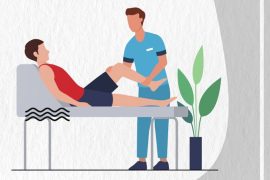Winter can pose challenges for individuals dealing with bone and joint issues, particularly for those with arthritis who may experience increased pain, stiffness, and swelling in their joints. While there isn’t a definitive direct link between joint pain and winter, various lifestyle and environmental factors could contribute to joint discomfort during colder months. Some studies suggest that cold temperatures may cause muscles to tighten, leading to reduced mobility and flexibility in joints. Additionally, changes in barometric pressure, commonly associated with weather changes, have also been linked to joint pain. As such, individuals with bone and joint concerns may find it beneficial to take extra precautions and manage their conditions effectively during the winter season.
Consuming more food:
During the colder months, individuals may be prone to consuming more food, and this increase in calorie intake can have implications for joint health. It’s crucial to be mindful of dietary habits during the winter season, as overeating and subsequent weight gain can put additional pressure on the joints. The availability of a variety of foods, including high-calorie options like parathas and chikkis, can contribute to this tendency.
Even a modest weight gain can have a significant impact, particularly around the knee joints. In fact, gaining just one kilogram of weight can increase the pressure on the knee joint by three times. This added stress on the joints can lead to an increase in pain perception, especially for individuals already dealing with joint issues or conditions like arthritis. Therefore, maintaining a balanced and healthy diet, coupled with regular exercise, becomes essential to support joint health, particularly during the winter season when dietary indulgences are common.
Several factors contribute to joint pain during winter:
- Vitamin D Deficiency: Reduced exposure to sunlight during winter can lead to Vitamin D deficiency, which is crucial for joint health. Consider spending some time outdoors in the sun or consulting with a doctor for supplements.
- Decreased Physical Activity: Winter often brings less physical activity due to the cold weather. Lack of movement can contribute to weight gain and joint stiffness. Engaging in regular exercise, even indoors, helps maintain joint flexibility and overall health.
- Mood and Perception of Pain: Gloomy weather and reduced sunlight can impact mood, potentially leading to an increased perception of pain. Maintaining a positive mental state and incorporating activities that boost mood can be beneficial.
- Viral Infections: Winter is associated with an increased prevalence of viral infections. Staying indoors and close proximity to others can facilitate the spread of infections, contributing to joint pain.
- Air Pollution: Winter often sees higher levels of air pollution, which may exacerbate aches and pains. Managing exposure to pollutants and maintaining good indoor air quality can help.
Tips for Managing Joint Pain in Winter:
- Exercise: Regular physical activity helps improve circulation, reduce stiffness, and maintain joint flexibility. Aim for at least 150 minutes of moderate exercise per week.
- Diet Regulation: Be mindful of calorie intake, especially with the likelihood of increased winter eating. A balanced, nutritious diet can support joint health. Consider avoiding inflammatory foods, such as red meat.
- Sun Exposure: Spend time in the sun to allow the synthesis of Vitamin D. If deficient, consult with a healthcare professional about supplementation.
- Hydration: Stay adequately hydrated, particularly during viral infections. Taking measures, such as wearing masks, can prevent the spread of infections.
- Avoid Inflammatory Foods: Opt for a diet that reduces inflammation, including whole foods and minimal processed foods. Limit salt and sugar intake for overall joint health.
By incorporating these practices, individuals can better manage joint pain during the winter season and support overall joint health. It’s essential to consult with healthcare professionals for personalized advice and recommendations.
Disclaimer:
The information contained in this article is for educational and informational purposes only and is not intended as a health advice. We would ask you to consult a qualified professional or medical expert to gain additional knowledge before you choose to consume any product or perform any exercise.







